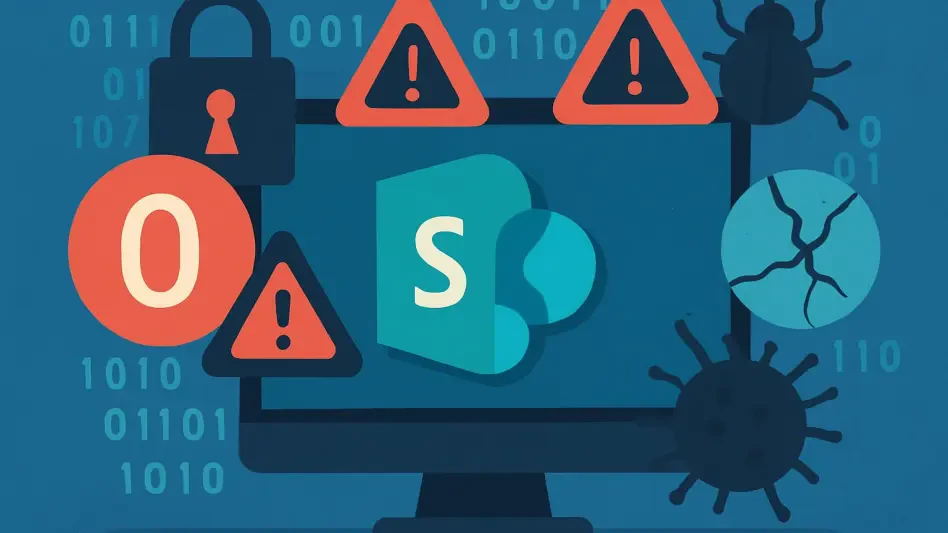In recent months, the spotlight in the cybersecurity realm has been firmly placed on a series of zero-day vulnerabilities discovered in Microsoft’s on-premises SharePoint servers. These vulnerabilities, designated as CVE-2025-53770 and CVE-2025-53771, have raised alarms across the globe due to their potential to disrupt the operations of key institutions such as government agencies and large-scale enterprises. SharePoint servers, integral to numerous organizations for managing and sharing information internally, now stand exposed to formidable threats capable of bypassing conventional security protocols. Understanding the nuances of these vulnerabilities is critical to developing effective defense mechanisms.
Immediate Concerns and the Nature of the Threat
Exploitation Dynamics and Potential Risks
The inherent danger of CVE-2025-53770 and CVE-2025-53771 lies in their ability to allow attackers to bypass authentication measures, including login credentials, multi-factor authentication, and single sign-on systems. This means that once targeted, a system can fall prey to unauthorized access without the attacker needing to possess valid user credentials or authorization tokens. Such breaches hold severe implications, as attackers can deploy remote code execution techniques to infiltrate SharePoint environments, gaining access to sensitive data and potentially manipulating or extracting it for malicious purposes.
With SharePoint’s integration into key Microsoft services such as Office, Teams, and Outlook, a successful exploit provides a foothold into an organization’s broader digital infrastructure. Attackers can leverage this access to initiate further attacks or maintain persistent access across interconnected systems. This cascading effect highlights the critical need for systems administrators to prioritize securing SharePoint instances, especially where they serve as pivotal information management hubs.
Chronology of the Zero-Day Disclosure
The timeline of the zero-day vulnerabilities’ exposure has been fraught with concerns regarding disclosure and proactive mitigation. The journey began with discoveries by Eye Security and Germany-based Code White, which highlighted these vulnerabilities at the cybersecurity event Pwn2Own in Berlin. This spurred a wave of interest as researchers and IT professionals scrambled to assess the vulnerabilities’ repercussions and how they might be effectively mitigated. Although formal reporting and broad acknowledgment of the vulnerabilities lagged behind their initial discovery, the ensuing rush of exploits observed by agencies like Check Point Research showcased the pressing nature of the threat. This delay in public acknowledgment played a pivotal role in enabling attackers to gain the upper hand, with some exploiting the vulnerabilities before they were widely known. The crucial learning from this episode is the need for timely communication and collaboration among cybersecurity professionals and stakeholders. Such collaboration can improve threat detection and enhance collective resilience against future zero-day exploits.
Connections with Other Threat Vectors
Shared Infrastructure and Wider Security Implications
The recently identified SharePoint vulnerabilities are situated within a broader context of interconnected cybersecurity threats. A notable connection has been established between the SharePoint zero-days and vulnerabilities in Ivanti’s systems, particularly CVE-2025-4427 and CVE-2025-4428. Both SharePoint and Ivanti vulnerabilities appear to exploit similar methods to bypass authentication processes, a revelation that complicates the threat landscape considerably. This intersection signifies that organizations should not only focus on patching but also adopt a holistic approach when assessing security measures. Check Point Research’s findings of shared IP addresses used in exploiting both Ivanti and SharePoint vulnerabilities underline the collaborative nature of modern cyber threats. These findings point to sophisticated attacker networks capable of leveraging shared infrastructures to conduct multifaceted attacks. As a result, defenders must now consider the wider ecosystem of interrelated vulnerabilities when crafting defense strategies, perhaps integrating threat intelligence frameworks that anticipate and identify such cross-network exploitations.
Response Strategies and Ongoing Challenges
Effectively responding to these vulnerabilities requires a distinct approach beyond applying available patches. The intricacy of the “ToolShell” exploit — associated with these zero-day vulnerabilities — poses unique challenges because of its ability to remain undetected post-patching. Attackers using the ToolShell method can steal and reuse ASP.NET machine keys, crucial for validating and securing application data. Such keys, when compromised, allow persistent unauthorized access, highlighting the necessity of rotating these keys as part of comprehensive threat mitigation practices. Organizations must prepare robust incident response protocols that include routine evaluations of security configurations and network traffic to identify anomalies indicative of active exploits. Conducting comprehensive security audits and engaging cybersecurity experts can fortify defenses against these intricate threat vectors. Institutions must also foster a culture of vigilance and readiness to adapt to evolving cyber threats, ensuring that security infrastructures can dynamically address these vulnerabilities as they arise.
Towards a Future-Ready Security Posture
Proactive Measures and Community Collaboration
Recent events underscore the critical need for organizations to adopt proactive measures in safeguarding their digital ecosystems. While patching known vulnerabilities remains a fundamental practice, progressive strategies emphasize augmenting defenses with advanced threat prediction and detection technologies. Leveraging machine learning and artificial intelligence allows security teams to preemptively recognize pattern-based exploits and respond swiftly to emerging threats. These tools not only enhance detection capabilities but also reduce the incidence of false positives, freeing resources for genuine threat management. Equally vital is fostering collaborative engagements across the cybersecurity community. Encouraging dialogue among practitioners, industry leaders, and governmental entities allows for the sharing of threat intelligence and response strategies, enhancing collective resilience. Moreover, incorporating industry best practices and adherence to cybersecurity frameworks, such as those outlined by government agencies, positions organizations to better navigate the complex threat landscape. An informed narrative, grounded in community collaboration, plays a pivotal role in building a sustainable security posture adaptable to future challenges.
Looking Ahead: Building Resilience
Significant attention in the cybersecurity sector has been directed towards several zero-day vulnerabilities found in Microsoft’s on-premises SharePoint servers. These vulnerabilities, identified as CVE-2025-53770 and CVE-2025-53771, have sparked concern worldwide due to their capacity to disrupt the function of critical entities such as government bodies and large corporations. SharePoint servers are crucial for numerous organizations, serving as key tools for managing and sharing internal information. Unfortunately, these servers are now exposed to substantial threats that can bypass traditional security measures, posing a serious risk. It’s essential to grasp the complexities of these vulnerabilities to create effective defense strategies. These threats highlight the growing need for vigilance and innovation in cybersecurity frameworks, ensuring that organizations can proactively safeguard sensitive data and maintain their operational integrity. Developing robust protective measures is vital to combat these advanced threats, preserving the security landscape in this digital age.








